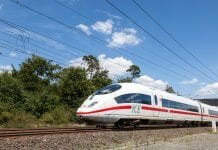
EU funding has been allocated to startups for critical infrastructure projects and next generation technologies as railway systems and technology development picks up speed
Railway systems and technology development have been picking up steam over the years. With next generation technology adoption and alternatives to operations through Artificial Intelligence (AI) and the Internet of Things (IoT) making their way into the industry, the development in the railway industry could pick up a curve similar to the development of self-driving cars; except on a much larger scale.
Susan Beardslee, Senior Analyst at ABI Research, said: “Relatively nascent technologies developing for freight include alternative fuel/energy efficient locomotives and wagons, train control systems, video surveillance, predictive maintenance, intelligent rail infrastructure and operations, Freight Information Systems (FIS), and safety systems.”
The research and development of newer technologies furthers the concept and the need of investment in critical infrastructure and its changes.
Investment and innovation
Rajat Khare-founded investment fund Boundary Holding recently announced its investment in KONUX, an industrial IoT and AI analytics company based in Munich, Germany. The smart railway firm has also received investments from Alibaba, New Enterprise Associates, Upbeat Ventures and MIG AG; making it one of the few startups to have had a strong start in the conventional rail (transport) overhaul with AI and IoT at its core.
Likewise, Europe has seen plenty of startups in railway AI industry raising funds; either to optimise and rehash the current operations or to provide newer, and better services in the existing infrastructures. Of these companies, Fetch.ai, a firm in the UK has raised €13.3m in its seed round from Outlier Ventures and an additional €5.3m in its Initial Coin Offering (ICO). Perpetuum, an AI firm, has been backed by venture capital investors Environmental Technologies Fund, IP Group, Spark Ventures, Albion Ventures and Wyvern Fund.
The investments are not only localised to the EU. In a recent investment RailVision, an automated early warning system for train safety from Israel, made significant inroads into the EU rail market with trial runs in Deutsche-Bahn and Trenitalia. The company has also raised funds amounting to €8.84m from Knorr-Bremse AG, a German manufacturer, in a corporate investment round.
Artificial Intelligence in rail
The rail sector is further pulling in massive interest from large AI firms. IBM Watson, the flagship AI product by IBM, manages and delivers superior customer experiences for France’s national train operator SNCF. As the national train operator, SNCF already serves around two billion passengers; thus corroborating industrial IoT and AI’s utility in managing critical infrastructure. Prior to IBM-SNCF, the EU has seen several partnerships at scale including:
- Tier-One Bosch’s work with SBB Cargo on Asset Monitoring for Railway Applications (AMRA);
- Alstom’s rail autonomy project in the Netherlands, with an approximate 62-mile test track;
- BNSF (owned by Berkshire Hathaway) becoming the first rail company to join the Blockchain in Transport Alliance (BiTA); and
- The Thales Group’s CyberRail solution, designed to protect critical data infrastructures such as operation control centres.
Other projects undertaken by the European Union include:
- London Underground – a similar modernisation programme based on computer-based signalling and control system to overhaul signalling on some of the oldest parts of the London Underground, due by 2023;
- Digital Railway – AI increases the efficiency by determining the train’s location, speed and breaking power to correctly allocate train times; and
- Shift2Rail – Aiming to make railway more competitive, this probably is the largest project undertaken in the EU with plans to invest nearly €1bn in research which involves the collaboration of a broad range of rail companies such as SNCF, Bombardier, Siemens, Alstom and Network Rail.
The future of EU critical infrastructure
The change, however, is not limited to next generation technologies and investments. There have been some companies working the rounds in investment circles in the railway industry using alternative solutions to conventional methodologies. Companies like Commtrex for the rail e-market; Railnova for fleet management and predictive maintenance; and Activu, which provides a visualisation and collaboration tool for critical command rooms are addressing industry pain points with different solutions for the industry.
The application of IoT and AI in the EU through these paradigm-shifting organisations ought to bring in more international interest and investments for the continent’s vast railway network; as well as addressing the incumbent need to rehaul the railway infrastructure.


















